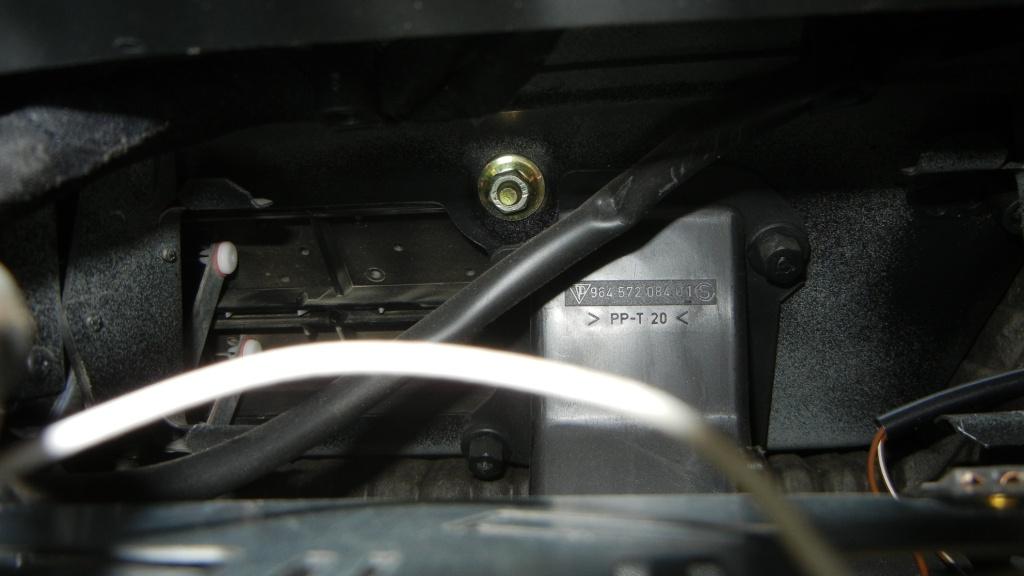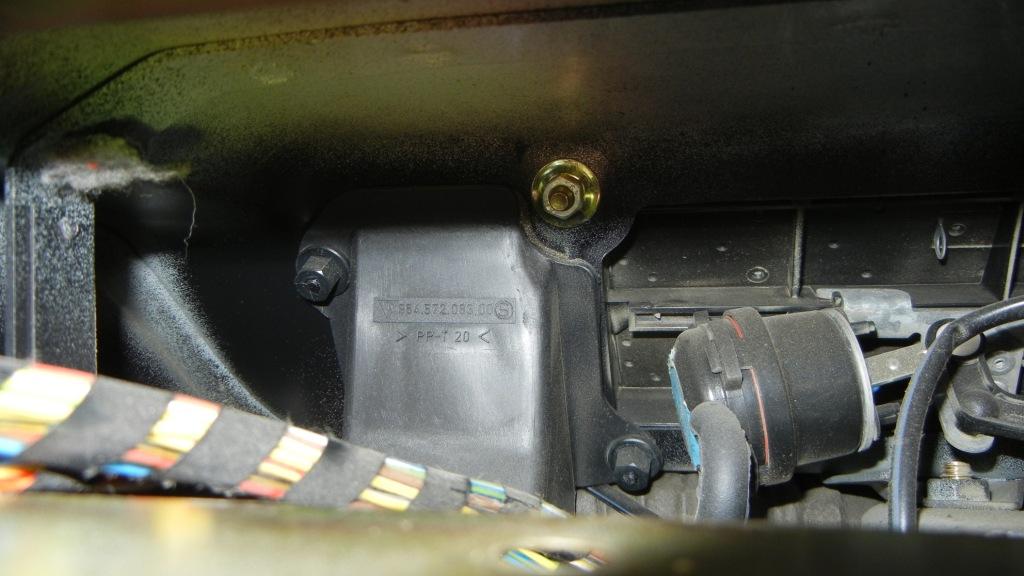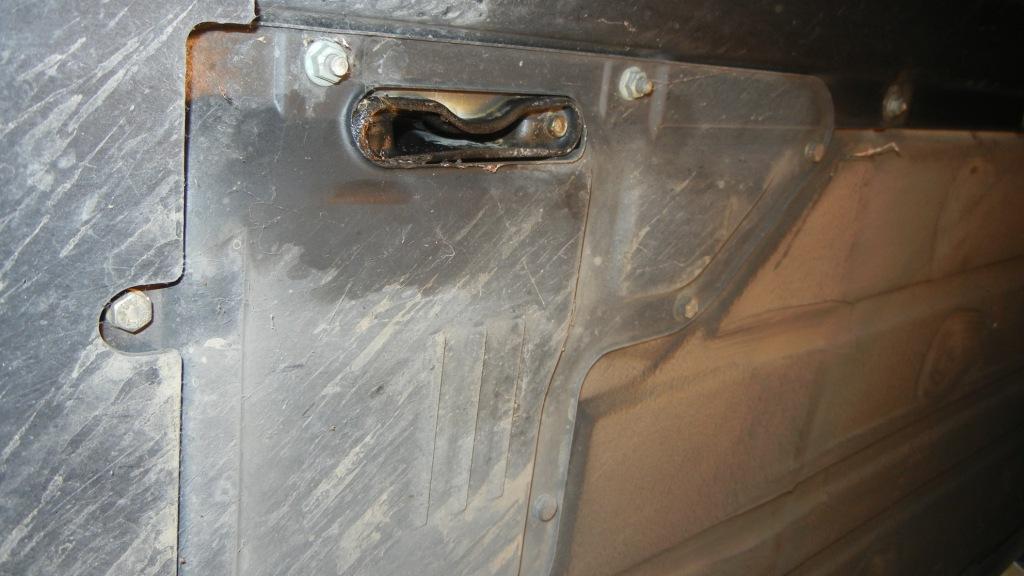How to find AC leaks?
#17
Addict
Lifetime Rennlist
Member
Lifetime Rennlist
Member
Thread Starter
LuckyJ,
I don't think the sound you describe is normal. You may have a vacuum leak or a failed servo. If you go to our friend Tore's site, you will find great information on this topic:
http://www.porschehvac.bergvill.com/
I don't think the sound you describe is normal. You may have a vacuum leak or a failed servo. If you go to our friend Tore's site, you will find great information on this topic:
http://www.porschehvac.bergvill.com/
#22
Addict
Lifetime Rennlist
Member
Lifetime Rennlist
Member
Thread Starter
NC TRACKRAT,
I watched a video on replacing a conventional Schraeder valve core in an AC service port. It's a slick tool that allows this to be done without evacuating the system. AFAIK, the valves on our 993 AC are not Schraeder--looking into the valve, I don't see any way to engage the core to remove or tighten it, if it is leaking. How was yours replaced?
I also found a video on checking the valves for leakage. It's a slick idea--just remove the valve cap and slip a small balloon (like a water balloon) onto the valve--if the balloon inflates, the valve is leaking. I plan to check my service valves this way, just to be sure.
I watched a video on replacing a conventional Schraeder valve core in an AC service port. It's a slick tool that allows this to be done without evacuating the system. AFAIK, the valves on our 993 AC are not Schraeder--looking into the valve, I don't see any way to engage the core to remove or tighten it, if it is leaking. How was yours replaced?
I also found a video on checking the valves for leakage. It's a slick idea--just remove the valve cap and slip a small balloon (like a water balloon) onto the valve--if the balloon inflates, the valve is leaking. I plan to check my service valves this way, just to be sure.
#23
Rennlist Member
BobbyT, after ascertaining that the port was the culprit, we went on a search to find aftermarket subs, to no avail. Parts are at the shop now. Plan to change out Wed. Will evacuate, change out service ports, draw a vacuum, then fill to spec. and re-check for any loss. To our knowledge, they are Porsche-specific. Good idea with the balloon test but, if the leak is miniscule, it could take some time to produce results.
#24
We had a client drive his car over to our shop because his shop could not figure out why 3 brand new pressure switches failed in a brand new system.
We don't call it Red Angel, we call it Red Death.
The entire system had to be disassembled and flushed.
The compressor and drier could not be flushed.
#25
Rennlist Member
BTW, the 3-way pressure switch in our 993s kicks the system out at 27 bar (391 psi), although the OFN test is performed statically.
#26
A pressure test with air or nitrogen will not show you where the leak is unless you can see the leak.
The standard procedure starts with a visual inspection for signs of refrigerant oil, say around a hose fitting or the compressor pulley, for a schrader valve you put a dab of water on it. The next step is an electronic leak detector, system running to check the high side of the circuit, system off to check the low side.
The most common leak point is the evaporator core, hence you need to sniff the vents and the condensate drain tube. Other points are the compressor, compressor hoses and then the condenser, driers, service ports (schrader valves) and other connections are not common but they can happen.
The standard procedure starts with a visual inspection for signs of refrigerant oil, say around a hose fitting or the compressor pulley, for a schrader valve you put a dab of water on it. The next step is an electronic leak detector, system running to check the high side of the circuit, system off to check the low side.
The most common leak point is the evaporator core, hence you need to sniff the vents and the condensate drain tube. Other points are the compressor, compressor hoses and then the condenser, driers, service ports (schrader valves) and other connections are not common but they can happen.
#28
I recently diagnosed my leak to be in the expansion valve. It's hard to see, but you could stick a paper towel under the exp valve and move it around with a screwdriver. Pull it back out and inspect for traces of PAG oil. In my case this was affirmative and replacing this fixed it.
I did notice that if you pull out the driver's side pollen filter then you can partially see the evaporator box though the opening for the pollen fitler. All the pics I've seen posted here showed the bottom of the evap box to be grimy and caked with dirt once there is a leak there. Sticking a snake light in there I could see that my evap was clean. HTH.
BTW, you will need to replace the dryer if you've got air in the system.
I did notice that if you pull out the driver's side pollen filter then you can partially see the evaporator box though the opening for the pollen fitler. All the pics I've seen posted here showed the bottom of the evap box to be grimy and caked with dirt once there is a leak there. Sticking a snake light in there I could see that my evap was clean. HTH.
BTW, you will need to replace the dryer if you've got air in the system.
#29
I use 2 different models; it's all a matter of preference/need/application.
A very old but reliable TIF 5650A, and a rather inexpensive TIF RX-1A
Unless you are using one often, you might not notice the difference between technologies (corona, ultrasonic, heated pentode, or IR).
If you get something that is too sensitive, or you are not familiar with its capabilities, the other gases in the area or an ant's fart will set it off, or conversely a windy day or testing by a blower fan will leave you pondering.
I recall a newbie mechanic who called us once stating the entire length of a brand new evap or compressor line on a 911 was leaking "through the hose", lol.
As compared to 20 years ago, the cost has come down so much and there is extensive competition. However, if you think you want to spend $150 or more for something you are going to use once a year, it might be a cost benefit to pay an experienced tech $50, or $25 and case of Becks, and ask him where the leak is. Its your choice.
A very old but reliable TIF 5650A, and a rather inexpensive TIF RX-1A
Unless you are using one often, you might not notice the difference between technologies (corona, ultrasonic, heated pentode, or IR).
If you get something that is too sensitive, or you are not familiar with its capabilities, the other gases in the area or an ant's fart will set it off, or conversely a windy day or testing by a blower fan will leave you pondering.
I recall a newbie mechanic who called us once stating the entire length of a brand new evap or compressor line on a 911 was leaking "through the hose", lol.
As compared to 20 years ago, the cost has come down so much and there is extensive competition. However, if you think you want to spend $150 or more for something you are going to use once a year, it might be a cost benefit to pay an experienced tech $50, or $25 and case of Becks, and ask him where the leak is. Its your choice.
#30
POACB
Rennlist Member
Rennlist Member
If you have radio removal tools handy, you can actually see the evaporator through the vent inside the dashboard behind the radio. The vents are closed in these pictures. You will have to set the ac so that the flaps are open. The second photo is the actuator for the vent flaps.
Here are a few of photos. The last is the drain under the car by the fuel pump which in my case was stained with oil.



Here are a few of photos. The last is the drain under the car by the fuel pump which in my case was stained with oil.






